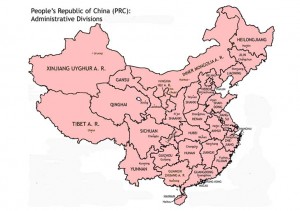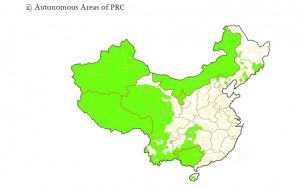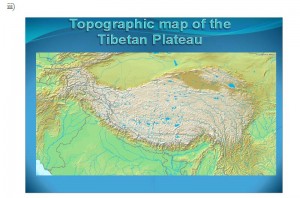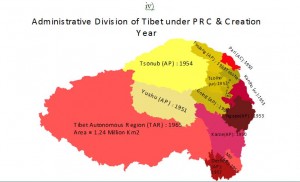Rinpoche’s Address on Round Table Discussion on “Greater Tibet” New Delhi
Since 1979, His Holiness the Dalai Lama has adopted the Middle-Way Approach of not seeking separation but for Tibet to remain within the People’s Republic of China (PRC). His Holiness the Dalai Lama has repeatedly requested for the implementation of National Regional Autonomy provisions to the entire Tibetan nationality in order to preserve and promote Tibet’s cultural and spiritual heritage and identity.
Since 1951, during the negotiations for the 17-point agreement, the Tibetan side had asked for one autonomous administration for the entire Tibetan nationality. Since then, this aspiration of Tibetan people has remained consistent.
In 2002, after the restoration of direct contact between Dharamsala and Beijing, eight rounds of formal dialogue and one informal consultation were held between the envoys of His Holiness the Dalai Lama and the concerned PRC officials. In the process, we have further clarified how the entire Tibetan nationality can be brought under one autonomous administration within the provisions of constitution and autonomy law and what are the advantages by doing this.
Unfortunately, the PRC officials twisted our argument by saying His Holiness the Dalai Lama is demanding “Greater Tibet”. Although we never use the phrase “Greater Tibet” at any time, this propaganda can create confusion or misunderstanding in the minds of people who do not have full understanding of the issue.
I appreciate the Tibet Study Group for arranging this round table discussion and allowing me to submit the reality in detail.
1. Definition and usage of “Greater Tibet”
The expression “Greater Tibet” has been used by ancient Indian scholars to indicate the geographical distance of the parts of Tibet from India. The regions of Tibet which border India or are near it were called Tibet (Bhota) and the regions of Tibet which are far away from India were known as Greater Tibet (Mahābhota).
In Sanskrit idiom, with reference to geographical area, distant places are usually qualified by the word greater. For example, the jungle which is near a town is called jungle (Arañya) and the jungle which is far away from the town is known as greater jungle (Mahārañya). Indeed this expression doesn’t refer to size or quality but it connotes distance.
In the ancient times, the Chinese and Tibetans, occasionally, used to refer each other as Great China and Great Tibet as an honorific word. But these were used referring to the whole of China and whole of Tibet not specifying the parts of the territory. Sino-Tibetan treaty of 821-822 also used the word Great Tibet and Great China. Later on, Chinese changed this honorific word from Great Tibet to High Tibet, which indicates high plateau rather than greatness. During the Ming and Manchu period, they coined different words to indicate different parts of Tibet such as familiar Tibet and unfamiliar Tibet to distinguish between Tibetan areas which border China and those which are far away from China.
However, Tibetans themselves have never used the word “Greater Tibet” to classify any part of Tibet. There are traditional ways of distinguishing regions of the country such as upper, middle and lower or U-tsang, Kham and Amdo or the three Cholkas, etc.
The Republic of China’s, pre-1949, official term for distinguishing different parts of Tibet was Inner Tibet and Outer Tibet, similar to that of Mongolia which was identified between Inner and Outer Mongolia. Inner Tibet refers to the regions which were under China by that time and outer Tibet refers to independent or autonomous Tibet. These terms were used in the documents of the Shimla Convention (1913-14) by the three parties.
2. Propaganda over “Greater Tibet”
In recent times (after 1979) the authorities of the PRC coined the new term, “Greater Tibet”, to refer to the total areas habited by Tibetan nationality which are at present divided into Tibet Autonomous Region and other Tibetan autonomous prefectures and counties.
In reality, Tibet is Tibet. There is no greater or smaller Tibet. All Tibetans belong to one minority nationality among the 55 minority nationalities of the PRC.
Beijing tries to mislead the international community by saying that His Holiness the Dalai Lama is demanding “Greater Tibet” which is one fourth of the PRC’s territory. This propaganda is done to make people believe that His Holiness the Dalai Lama’s aspiration is unreasonable and that he is asking for separation of one fourth of the PRC or that His Holiness is asking for inclusion of certain areas into autonomous region that are not already declared as Tibetan autonomous areas.
In reality, His Holiness the Dalai Lama has never used the word “Greater Tibet” at any time verbally or in written document. If someone surveys the entire correspondences, statements, documents and any other written dossiers of the Tibetans since 1979, one will not find a single instance of the word “Greater Tibet” being used. This is PRC’s word, which they are trying to project as if it is His Holiness the Dalai Lama’s position.
3. What is His Holiness the Dalai Lama asking for?
What His Holiness the Dalai Lama is asking the PRC’s central government to do is the following:
- to have one autonomous administration for all the Tibetan autonomous areas
- to genuinely implement the constitutional provisions of national regional autonomy
His Holiness the Dalai Lama has made these requests in accordance with the spirit of the PRC Constitution and its Autonomy Law.
a) Article 4 of the Constitution says:
All nationalities in the People’s Republic of China are equal. The State protects the lawful rights and interests of the minority nationalities and upholds and develops a relationship of equality, unity and mutual assistance among all of China’s nationalities. Discrimination against and oppression of any nationalities are prohibited; any act which undermines the unity of the nationalities or instigates division is prohibited.
The State assists areas inhabited by minority nationalities in accelerating their economic and cultural development according to the characteristics and needs of the various minority nationalities.
Regional autonomy is practiced in areas where people of minority nationalities live in concentrated communities; in these areas organs of self-government are established to exercise the power of autonomy.
All national autonomous areas are integral parts of the People’s Republic of China.
All nationalities have the freedom to use and develop their own spoken and written language and to preserve or reform their own folkways and customs.
b) Preamble of the National Regional Autonomy Law says:
Regional national autonomy means that the minority nationalities, under the unified state leadership, practise regional autonomy in areas where they live in concentrated communities and set up organs of self-government for the exercise of power of autonomy. Regional national autonomy embodies the state’s full respect for and guarantee of the right of the minority nationalities to administer their internal affairs and its adherence to the principle of equality, unity and common prosperity for all its nationalities.
c) Similarly article 2 of the Autonomy Law says,
Regional autonomy shall be practiced in areas where minority nationalities live in concentrated communities. National autonomous areas shall be classified into autonomous regions, autonomous prefectures and autonomous counties.
All national autonomous areas are integral parts of the People’s Republic of China.
d) Division of minority nationalities who live in a concentrated community is a direct violation of the Constitution as quoted above. This resembles the policy of “divide-and-rule’’ adopted by the imperialist regimes in the past. How one can expect the unification of all nationalities as a whole without unifying the minority nationalities themselves?
In fact, a senior party member, Phuntsok Wangyal, rightly said, “..it has been proven that the policy of ‘administrating Tibet’ which calls for ‘divide-and-rule policy’ is a mistake and historically this is a bitter lesson. If the thinking of Big Nationality Supremacy is abandoned – especially the bias in the nationalities policy that suggests ‘divide-and-rule,’ then there would not be any problems in changing and adjusting the administrative division policy.”
e) Preamble of the Constitution solemnly declares,
The People’s Republic of China is a unitary multi-national State created jointly by the people of all its nationalities. Socialist relations of equality, unity and mutual assistance have been established among the nationalities and will continue to be strengthened. In the struggle to safeguard the unity for the nationalities, it is necessary to combat big-nation chauvinism, mainly Han chauvinism, and to combat local national chauvinism. The State will do its utmost to promote the common prosperity of all the nationalities.
In order for you to have a clearer picture I would like to present some maps. These maps are taken from various sources only to show internal administrative divisions of the PRC. Their international boundaries are not necessarily accurate and do not reflect the views of this author.
4. PRC’s objection and Tibetan position
Now I would like to respond to the PRC’s objection from our point of view.
i) The size of area:
The PRC authorities say that the Tibetan autonomous areas cannot be put under one administration because the area is so large and it constitutes one fourth of the PRC’s territory.
It is true that the Tibetan area constitutes one fourth of the PRC’s territory, but it was not created by us. In fact, it came about by natural process and has existed since time immemorial, which no one can change at this point of time. It is not that Tibetan people have moved into these areas in recent times. They were in these areas right from the beginning of human civilization in Tibet. Tibetans are the indigenous inhabitants of these areas throughout history.
ii) Size should not matter:
The area of Tibet may appear quite large but we are not seeking separation and are willing to remain as an autonomous region of the PRC. Despite its largeness or smallness, Tibet will remain within the territory of the PRC. There are other large autonomous regions as well such as Xinjiang Uygur Autonomous Region and Inner Mongolia Autonomous Region. In case of the Xinjiang Uygur Autonomous Region, it constitutes about one sixth of the PRC territory and the Inner Mongolia Autonomous Region is about one eighth. Therefore, the size of a territory should not be a hindrance to making one autonomous region for the people of the same nationality.
In fact, 64.3% of the PRC’s total territory belongs to 155 autonomous areas for 55 minority nationalities. This is despite the fact that the population of these minority nationalities constitutes only 8.46% of the total population of the PRC.
The PRC authorities did not hesitate to make 64.3% of its total territory as autonomous areas because these areas remain within the PRC’s territory. Article 4 of the Constitution declares that “..All national autonomous areas are integral parts of the People’s Republic of China.” The crucial point is that whether the Tibetan autonomous areas remain within one administration or under several administrations does not change either the size of the Tibetan autonomous areas or the total size of the autonomous areas of the PRC.
Not putting the entire Tibetan autonomous areas under one administration does not reduce the size of the Tibetan autonomous areas. Anyway, the Tibetan autonomous areas constitute one fourth of the PRC’s total territory.
Therefore, the size of areas has no relevance with the function of one administration or several administrations for the Tibetans.
iii) Not history but nationality:
The PRC authorities say that Tibetans have never remained under one administration in history. But this is not true.
a) Tibetans were under one administration until the mid 9th century. Later Tibetans were again re-integrated into one administration in 1260 under Drogon Choegyal Phakpa. This was offered to him by emperor Kublai Khan and this offering explicitly refers to the three Cholkas with clear demarcation of its borders. Such unified administration remained until 1730s. Parts of the Tibetan areas were merged into Sichuan, Gansu and Yunnan during the rule of Emperor Yongzheng, after Tibetan civil war between U and Tsang which invited Manchu’s influence in Tibet.
b) Moreover, we are not making any demand on the basis of history. As we all know, history is never static. Throughout history every country in the world, including China, has never remained exactly in the same status as it is now. For example, there is no history of Communist Party’s rule in China prior to 1949 but this doesn’t prevent Communist Party of China to rule the country for the last 60 years.
The basis of our demand is the concept of National Regional Autonomy for minority nationalities propounded by Marx, Lenin, Mao and the provisions enshrined in the Constitution of the PRC. The concept of National Regional Autonomy itself is not based on history but it is a concept that came out of a revolutionary principle.
iv) Re-adjustment of boundary is not a hindrance:
The PRC authorities argue that it is not possible to re-draw the boundary within the PRC.
a) But we perceive it possible because there is a provision for this in the National Regional Autonomy Law.
Article 14 of the Autonomy Law says:
The establishment of a national autonomous area, the delineation of its boundaries and the elements of its name shall be proposed by the state organ at the next higher level jointly with the state organ in the relevant locality, after full consultation with representatives of the relevant nationalities, before they are submitted for approval according to the procedures prescribed by law.
Once defined, the boundaries of a national autonomous area may not be altered without authorization. When an alteration is found necessary, it shall be proposed by the relevant department of the state organ at the next higher level after full consultation with the state organ of self-government of the national autonomous area before it is submitted to the State Council for approval.
b) Moreover, we are not seeking additional areas to be included in the Tibetan autonomous areas. It is only to make alterations in the administration. Instead of having several autonomous administrations, one autonomous administration should be established. It neither affects China’s borders with other countries nor its domestic boundaries, nor, above all, the territorial integrity of the Chinese state. Nor, is there a need of re-drawing the border between Tibetan autonomous areas and other provinces or autonomous areas.
v) Precedence of boundary re-adjustments in the PRC:
There is also precedence of re-adjusting the boundaries of autonomous areas and provinces. To cite a few examples:
a) Inner Mongolia Autonomous Region:
Inner Mongolia Autonomous Region was established in 1947, based on the Soviet nationalities policy of the Communist Party of China. Initially, it included just the Hulunbuir region. Over the next decade, after the founding of the PRC, Inner Mongolia was expanded westwards to include five of the six original leagues. Eventually, all areas with sizeable Mongol population were incorporated into the region, giving present-day Inner Mongolia its size and elongated shape.
Thereafter, in 1969, during the Cultural Revolution, most of the areas of Inner Mongolia were incorporated into nearby provinces. However, later in 1979, these were once again reorganized back into the Inner Mongolia Autonomous Region.
b) Guangxi Zhuang Autonomous Region:
Guangxi Zhuang Autonomous Region was founded in 1958 by transforming Guangxi Province into an autonomous region for the Zhuang nationality. However, Zhuang nationalities form a minority of Guangxi’s population. Even today, according to the 2000 census, Zhuang nationality constitutes only 32% of the total population of Guangxi Zhuang Autonomous Region.
In 1952 a small section of Guangdong’s coastline was given to Guangxi, giving it access to the sea. This was reversed in 1955, and again reversed back in 1965.
c) Hainan Province:
In 1988, Hainan Island was separated from Guangdong and became a new province.
d) Chongqing Municipality
In 1997, Chongqing was created as a directly administered municipality by excluding it from Sichuan province.
5. Not new but long overdue
For the whole of Tibet to come under one autonomous administration is not an afterthought or a fresh demand.
a) The issue was raised in 1951 during the negotiation of the 17-Point Agreement. The Tibetan delegation submitted a petition regarding this issue signed by Ngapo Ngawang Jigme, head of the Tibetan delegation. At that time Premier Zhou Enlai verbally responded by saying that the idea of unification of the Tibetan nationalities is appropriate but the time is not yet ripe.
b) On 29 September 1951, a three-point suggestion was made by the Kashag, the government of Tibet, to Zhang Jingwu (Central Government’s representative in Tibet). The first point was to have a single administrative entity for all the Tibetans.
c) In 1953, Dege Kelsang Wangdue, the deputy Chairman of Chamdo People’s Liberation Committee and others demanded that whole Tibetan nationality come under one administrative entity.
d) During the establishment of the Preparatory Committee of the Tibet Autonomous Region in 1956, a meeting was organized in Lhasa. In that meeting, Vice-Premier Chen Yi and other representatives of Chinese government said that it would be very beneficial for the development of the Tibetan area, unity and stability of the country and harmony between the Tibetans and Chinese peoples if a unified Tibetan Autonomous Region, with Lhasa as its center, was established by merging Tibetan areas in eastern provinces of Qinghai, Gansu, Sichuan and Yunnan with Central Tibet.
Later, the Central leadership dispatched a senior Communist Party member, Sangye Yeshi (Tian Bao), and appointed a special committee to make a detailed plan on the unification of the areas in the five provinces. However, this work could not make progress on account of ultra-leftist elements in Tibet.
e) Similarly, in 1980, a few Tibetan cadres of Kanlho Tibetan Autonomous Prefecture submitted a signed petition to the central government of China to establish a single administration for all the Tibetan areas.
f) The 10th Panchen Lama, the then Vice-chairman of National People’s Congress, said when inaugurating the Tibet Development Project, “The desire for the establishment of an autonomous region for a unified Tibetan nationality is appropriate and is in accordance with the legal rules. It is also in line with the views of the entire Tibetan population. The issue is only a matter of ripening the conditions and not about postponement or a reactionary issue.”
g) Central leadership’s acceptance for the unification of Tibetan areas in principle was acknowledged by senior party member Phuntsok Wangyal. He said, “The desire for a unified autonomous region of Tibet was accepted in principle by the Chinese government and its leaders in the 1950s…”
6. Benefits of a single administration for all Tibetan nationality
To the Central Government
- Will help to realize constitutional objectives of establishing equality and unity among all nationalities
- Will promote confidence and goodwill towards the Central Government among the minority nationalities in general and Tibetans in particular
- Will help to contain local nationalism
- Will ensure unity and stability of the PRC
- Will ensure peaceful coexistence and harmony between Tibetans and all other nationalities
- Will help to realize harmonious society and peaceful rise of China
To the Tibetan People
- Will help to protect and preserve unique Tibetan culture and identity which has a potential to provide valuable service for entire humanity
- Will help to protect Tibetan nationality from assimilation and disappearance
- Will help to protect Tibet’s fragile environment, which largely determines the environment of the entire Asian continent.
- Will help to enhance socio-economic development
To the Autonomous Government
- Will be easier to administer
- Will reduce administrative expenditure
- Will help to make integrated developmental plans and the usage of natural resources for the entire community
- Will help to make uniform policy of education, health, environment and social custom
- Will help to promote harmonious relation with the Central government, provinces and other autonomous areas
- Will help in implementing Central government’s policies and directives effectively for all Tibetan people
7. Conclusion
The basic aspiration of all the Tibetan people in today’s PRC to have a uniform policy that will enable them to preserve and promote their distinct identity is a right granted by the PRC constitution and relevant statutes. Keeping in view of above-mentioned facts, to make one autonomous administration for all Tibetan autonomous areas is appropriately desirable and easily achievable. For this to happen there is neither any need to make amendments to the Constitution nor any change in policy or political system is needed. It only requires a political will of the leadership.



